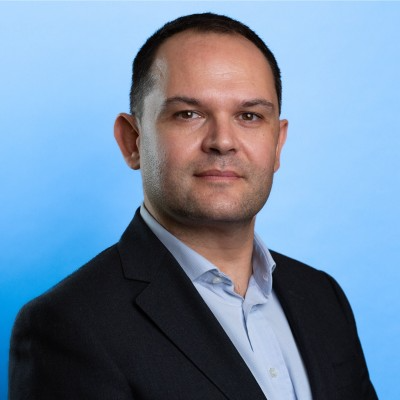Future of Finance Exchange - Day 1
7:45 am - 8:30 am
Event Registration and Breakfast
8:30 am - 8:45 am
Exchange Welcome & Chairperson's Opening Remarks
Armand Angeli -
Vice-President, Digital Transformation and AI Group,
DFCG
8:45 am - 9:15 am
Keynote - Leading Transformation Through Uncertainty – Building Confidence, Culture & Clarity in Finance
Muthumari Duraisamy -
Vice President Finance - EMEA & APAC,
Ranpak
Volatility is the new constant, and transformation is no longer a one-off initiative; it's how finance leads.
This session examines how CFOs and senior finance leaders leverage data-driven visibility, cultural resilience, and decisive leadership to capitalise on uncertainty and drive lasting performance.
Key Takeaways:
• Strengthening decision confidence through visibility and data clarity
• Building resilient, adaptive teams that thrive through change
• Embedding transformation as a continuous capability, not a one-time project
• Balancing human leadership with technology-enabled insight
• Creating the culture and mindset for sustainable growth
9:15 am - 9:45 am
Plenary Presentation - The Simplification Imperative – Streamlining Finance for Strategic Impact
How next-generation technology and smarter process design are transforming finance into a lean, agile value engine
Finance complexity is the enemy of agility. From fragmented systems to redundant processes, complexity drains resources and slows decision-making. Leading CFOs are now making simplification a board-level priority, systematically dismantling inefficiencies, streamlining data flows, and creating finance functions built for speed, clarity, and long-term impact.
This session explores how technology-enabled simplification and process intelligence are reshaping the operating model, and linking process redesign, data integration, and cultural change to deliver measurable ROI.
For technology, ERP and process automation providers enabling CFOs to simplify complexity and accelerate transformation.
9:45 am - 10:00 am
Networking Bingo
Time to get up on our feet and meet the people in the room! Grab a Bingo Sheet and identify your own number. Then look out for the numbers in the room that will help you get 5 in a row and hit “Bingo!” Follow the instructions on your card for a chance to win a prize!
Fragmented systems, duplicated data, and siloed reporting continue to drain productivity and cloud decision-making. In this forward-looking session, finance leaders explore how modern ERP and finance platforms are creating unified digital backbones that connect people, processes, and performance in real time. Learn how integration, data standardisation, and automation are enabling CFOs to simplify operations, enhance visibility, and drive transformation that scales.
10:40 am - 11:10 am One-to-One Business Meetings | Peer-to-Peer Networking
Finance leaders are increasingly being called upon to steady the ship during periods of disruption, whether from market shocks, operational challenges, or structural change. This session offers a practical exploration of how CFOs and senior finance executives can stabilise their organisations while continuing to build long-term resilience. It also looks at the human side of leadership under pressure, and maintaining clarity, empathy, and team confidence when uncertainty becomes the norm.
Discussion Points:
• Practical tactics for stabilising finance functions in times of disruption
• Cutting through the noise: identifying the metrics that really matter in times of disruption
• Developing the personal skillset needed to navigate short-term pressures without losing sight of long-term priorities
• Embedding sustainable ways of working that protect clients, employees, and the business
• Building emotional resilience and leading with empathy during sustained periods of uncertainty
11:15 am - 11:45 am
Plenary - AI eats spreadsheets for lunch: The CFO’s new co-pilot
Ivan Martić -
VP Business Development,
Farseer
Finance has entered a new phase. Excel built the foundation, but AI now drives the future. CFOs no longer work only with static data. They use AI to interpret context, predict outcomes, and automate routine tasks. FP&A tools with built-in AI transform how companies plan, forecast, and make decisions. Instead of manual modeling, finance teams can now ask questions and get instant insights. This shift makes the CFO a strategic co-pilot, not just a controller of numbers.
11:45 am - 12:15 pm
Plenary Panel Discussion - Beyond Survival Mode: Navigating Volatility and Balancing Short-Term Performance with Long-Term Value
William Fillias -
Finance Director - Products and Business Strategy,
GE Healthcare
Fabio Pesenti - CFO EMEA Emerging Markets, Zimmer Biomet
Andreea Popescu - Global Director Business Control Digital & Technology, The Heineken Company
How finance leaders manage competing time horizons while steering through forces beyond their control
12:20 pm - 12:50 pm One-to-One Business Meetings | Peer-to-Peer Networking
Static planning can’t keep pace with the volatility CFOs face. In this interactive session, finance leaders explore how next-generation FP&A platforms combine predictive analytics, automation, and agentic AI to deliver self-correcting forecasts that adapt in real time. Participants will explore how continuous forecasting connects performance management, capital allocation, and scenario planning, transforming finance from reactive reporting to proactive leadership.
12:55 pm - 1:55 pm
Networking Lunch
Fuel up and get ready for the second half of the day with our next Keynotes and our Day 1 Roundtables.
Uncertainty has become a defining feature of global business, from geopolitical shifts and tariff changes to supply chain disruption and market volatility. This interactive session offers a pragmatic look at how finance and strategy leaders can make confident, disciplined investment decisions amid unpredictable conditions. Participants will explore scenario-planning techniques, resilience frameworks, and communication strategies that help sustain business continuity and long-term value when external factors are beyond control.
3:10 pm - 3:55 pm
Plenary Panel - The AI Debates: Making AI Work for Finance – From ROI Reality to Operating Model Readiness
Muthumari Duraisamy -
Vice President Finance - EMEA & APAC,
Ranpak
Malgorzata Figaszewska - Director Global Finance, Franklin Templeton.
Fred Fowler - Global Head of Finance Services & Transformation Leader, Coty
Yorck Schmidt - CFO, AVL
Brian Kenny - CFO, Private Equity/VC Portfolio Companies
Many finance functions are experimenting with AI, but few have unlocked meaningful ROI. The reason isn’t a lack of technology; it’s the absence of a clear operating model that connects data, people, and platforms to business outcomes. This discussion explores the following themes:
· Defining “real ROI”: What measurable value from AI looks like in finance operations
· The accuracy paradox: Setting realistic expectations for AI versus human performance
· Organisational readiness: New roles, skills, and operating rhythms for AI-augmented finance
· Data as fuel: Embedding quality, governance, and accessibility for AI acceleration
· Platform integration: ERP, IBP, and analytics modernisation as foundations for success
· Human-in-the-loop: Designing oversight frameworks that balance risk and speed
· Implementation lessons: How to move from experimentation to scalable adoption
· Model governance & assurance: Establishing finance-grade validation, testing, and auditability for AI models, agents, and automated decision flows
· Enterprise risk & control alignment: Embedding AI into existing risk frameworks, ensuring controls, escalation paths, and accountability structures are updated for new operational, cyber, and compliance risks.
3:55 pm - 4:25 pm
Plenary - ‘Tech-ing’ Up Tax – Turning Compliance into a Strategic Asset: Why tax transformation belongs at the heart of the CFO agenda
The introduction of OECD Pillar Two, real-time reporting, and AI-driven enforcement means tax is no longer a back-office burden — it is now a critical test of finance’s ability to manage complexity and deliver strategic value. This session explores how leading CFOs and tax leaders are deploying technology to navigate global reforms, strengthen compliance, and unlock new sources of insight.
We’ll examine how automation, data integration, and advanced analytics are turning tax from a cost centre into a strategic asset — improving risk management, supporting capital allocation, and creating value in uncertain markets.
For tax technology, compliance and ERP partners transforming reporting into a strategic value driver.
For CFOs, transformation success is measured not in milestones but in measurable business outcomes. This session explores how finance can move beyond optimisation to become a true engine of enterprise value creation. Drawing on his experiences leading transformation programmes that delivered over £3bn in P&L benefits, this session explores how transformation can be both disciplined and daring, combining strategic alignment, cultural change, and executional excellence to deliver sustainable growth at scale.
Key Takeaways:
• Designing finance transformation programmes that deliver measurable enterprise value
• Aligning commercial, operations, and finance teams behind shared growth objectives
• Sustaining pace and confidence through multi-year transformation cycles
• Balancing governance and agility to ensure results translate to the bottom line
• Building credibility and influence by leading transformation that speaks in P&L terms

Ilya Selivanov
Finance & Transformation Lead, Senior Advisor Private Equity, former SVP ReckittReckitt
Finance leaders need a value lens that travels across investment cases, capital allocation, and performance reviews, without collapsing into “earnings at all costs.” In this practical, closed-door session, Ben Walters shares a CFO-ready framework that broadens value beyond profit and cost to include capital efficiency, resilience, and growth contribution. You’ll see how CPInsight can outperform familiar metrics (earnings, ROIC, EVA, cash conversion) as a decision and storytelling tool, then apply it to a live initiative to test alignment with long-term value creation.
Session Outline:
• Defining value creation beyond profit and cost: capital efficiency, resilience, and growth contribution
• Introducing CPInsight, a practical measure that outperforms Earnings, ROIC, EVA, and cash conversion
• Applying CPInsight across investment decisions, capital allocation, and performance reviews
• Aligning boards, investors, and business partners around a shared value framework
• Translating metrics into compelling narratives that resonate with both financial and non-financial stakeholders
• Interactive exercise: mapping a current initiative against the framework to test alignment with long-term value creation
Champagne Roundtables - The Skills Needed to Lead
Group B
5:40 pm - 6:25 pm AI IMPLEMENTATION: Designing the AI-Ready Finance Organisation Brian Kenny - CFO, ISS Facility Services UKGroup C
5:40 pm - 6:25 pm FINANCE TECH STACK: Platform Modernisation: ERP, IBP and the New Analytics StackHow does it work? This is a 45-minute discussion on the topic of your choosing, and a chance to hear and interact with peers while sharing your own expertise.
How does it work? This is a 45-minute discussion on the topic of your choosing, and a chance to hear and interact with peers while sharing your own expertise.





























